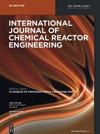使用改性Met-SWCNT-Ag纳米颗粒从水溶液中去除亚甲蓝:使用RSM-CCD的优化
IF 1.6
4区 工程技术
Q3 Chemical Engineering
International Journal of Chemical Reactor Engineering
Pub Date : 2023-06-05
DOI:10.1515/ijcre-2022-0240
引用次数: 0
摘要
摘要水资源中残留的有机染料具有致突变性、致癌性、致畸性等对健康的不良影响,对环境和人类健康构成威胁。因此,它们必须从工业废水中去除。在这些染料中,亚甲基蓝(MB)是一种有毒、致癌、几乎不可生物降解的染料,对人类健康和环境安全构成重大威胁。因此,在排放到环境中之前,它通过各种方法,包括吸附,从工业废水中去除。本研究旨在优化银纳米复合材料水溶液中MB在单壁碳纳米管甲硝唑(Met-SWCNTs/Ag)上的吸附条件。采用基于中心复合设计(CCD)的响应面法(RSM)对MB染料(污染物)在Met-SWCNTs/Ag上的吸附进行了优化和建模。采用硝酸银浸渍的方法合成了Met-SWCNTs/Ag。采用傅里叶变换红外光谱(FTIR)、扫描电镜(SEM)和x射线衍射(XRD)对制备的Met-SWCNT/Ag纳米复合材料进行了表征。研究了纳米颗粒/染料比、温度、pH和接触时间等4个自变量对MB去除对swcnts /Ag和Met-SWCNTs/Ag比表面积的影响。使用Met-SWCNTs/Ag去除MB模型的准确性和拟合度通过方差分析估计,R为0.99,p值< 0.0001。RSM结果表明,NP/Dye比对MB在Met-SWCNTs/Ag上的吸附影响最为显著。最佳吸附条件为NP/Dye比为2.21,接触时间为65.57 min, pH = 6.15 ,温度为25.79 ℃,MB去除率为98.94 %。等温线和动力学研究表征了吸附剂去除MB的吸附行为。Langmuir等温模型最能描述MB在Met-SWCNTs/Ag上的吸附行为,其回归系数r2为0.9935,最大Q为112.42 mg/g。研究了Met-SWCNT/Ag的吸附动力学,并采用拟一阶、拟二阶模型对其进行了建模,其中拟二阶模型拟合效果最好。热力学研究表明,MB染料的吸附是自发的、放热的。实验结果表明,与SWCNTs/Ag(~ 93 %)相比,经Met修饰的SWCNTs/Ag具有更高的去除效率(~ 98 %)。本文章由计算机程序翻译,如有差异,请以英文原文为准。
Methylene blue removal from aqueous solution using modified Met-SWCNT-Ag nanoparticles: optimization using RSM-CCD
Abstract The presence of residual organic dyes in water resources results in a threat for both environment and human health due to their adverse health effects such as mutagenicity, carcinogenicity, and teratogenicity. Thus, they must be removed from industrial wastewater. Among these dyes, methylene blue (MB) is a toxic, carcinogenic, and almost non-biodegradable dye and can pose a significant threat to human health and environmental safety. Thus, it is removed from industrial effluents by a variety of methods, including adsorption, prior to discharge into the environment. This study aims to optimize the adsorption conditions of MB from an aqueous solution with nanocomposite of silver onto single-wall carbon nanotube metronidazole (Met-SWCNTs/Ag). Response Surface Methodology (RSM) based on Central Composite Design (CCD) is used to optimize and model the adsorption of MB dye (as pollutant) on Met-SWCNTs/Ag. The Met-SWCNTs/Ag is synthesized using Met-SWCNT impregnated with silver nitrate. The produced Met-SWCNT/Ag nanocomposite is characterized by Fourier transform infrared spectroscopy (FTIR), scanning electron microscopy (SEM), and X-ray diffraction (XRD). The effect of four independent variables including nanoparticle (NP)/dye ratio, temperature, pH and contact time on MB removal on the specific surface area of SWCNT/Ag and Met-SWCNTs/Ag is evaluated. The accuracy and fit of the model for MB removal using Met-SWCNTs/Ag are estimated by ANOVA with R 2 > 0.99 and P-value < 0.0001. RSM results indicates that the NP/Dye ratio has the most significant influence on the adsorption of MB onto Met-SWCNTs/Ag. The optimal condition of the adsorption process takes place at NP/Dye ratio of 2.21, contact time of 65.57 min, and pH = 6.15 at 25.79 °C temperature leading into a 98.94 % MB removal. Isotherms and kinetic studies are performed to characterize the adsorption behavior of the adsorbent for MB removal. The adsorption behavior of the MB onto Met-SWCNTs/Ag is best described by the Langmuir isotherm model with regression coefficient R 2 of 0.9935 with the Q max of 112.42 mg/g. Adsorption kinetics of Met-SWCNT/Ag is investigated and modelled by means of the pseudo-first-order, pseudo-second-order models which is best fitted to the pseudo-second-order model. The thermodynamic study reveals that the adsorption of MB dye is spontaneous and exothermic. Experimental results suggest that the modified SWCNTs/Ag with Met achieves a higher removal efficiency of (∼98 %) when compared to SWCNTs/Ag (∼93 %).
求助全文
通过发布文献求助,成功后即可免费获取论文全文。
去求助
来源期刊
CiteScore
2.80
自引率
12.50%
发文量
107
审稿时长
3 months
期刊介绍:
The International Journal of Chemical Reactor Engineering covers the broad fields of theoretical and applied reactor engineering. The IJCRE covers topics drawn from the substantial areas of overlap between catalysis, reaction and reactor engineering. The journal is presently edited by Hugo de Lasa and Charles Xu, counting with an impressive list of Editorial Board leading specialists in chemical reactor engineering. Authors include notable international professors and R&D industry leaders.

 求助内容:
求助内容: 应助结果提醒方式:
应助结果提醒方式:


